White-cheeked Starling Spodiopsar cineraceus 灰椋鳥
Category I. Locally common but declining winter visitor, with recent breeding records.
IDENTIFICATION
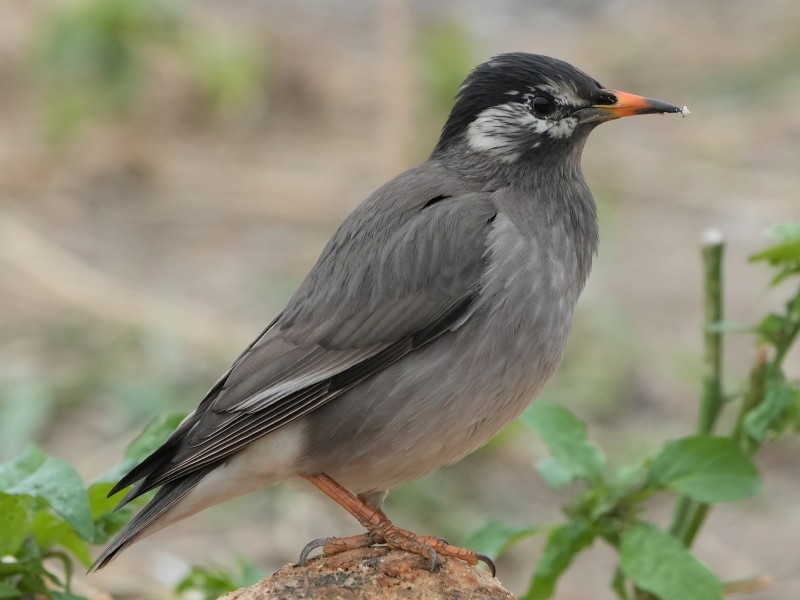
Oct. 2024, Paul Leader. Male.
22–24 cm. Brownish grey starling with whitish cheeks, white-tipped tail and white rump. Amount of white on face is variable, with some black streaking.
On male dark greyish head contrasts with brownish-grey mantle and back. Throat to upper breast sooty-grey, lower breast and flanks paler grey, belly and undertail-coverts white. Conspicuous orange bill and legs.
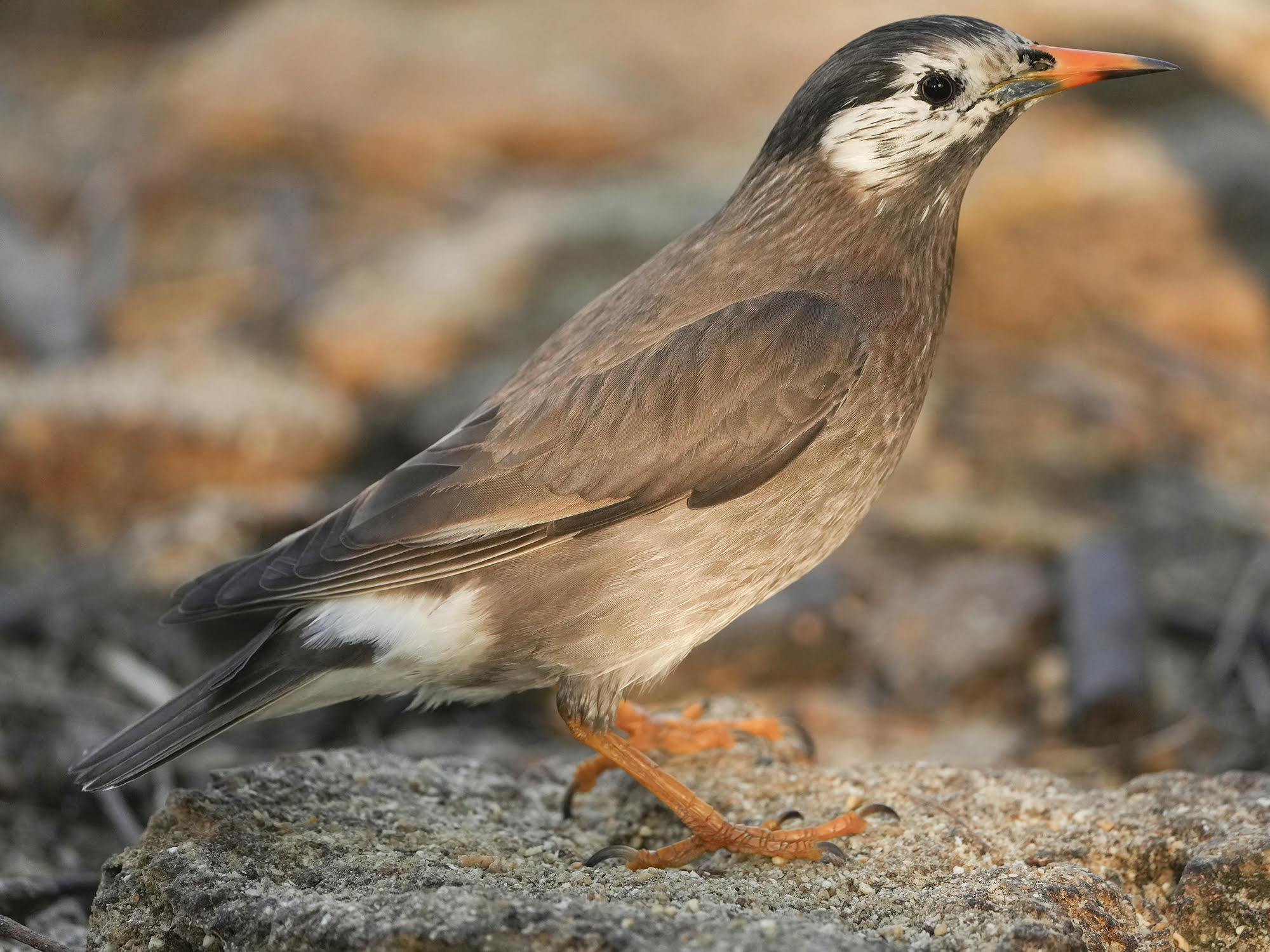
Feb. 2023, Paul Leader. Female.
The female is browner than the male with black confined to the crown, and has more extensive white on the face.
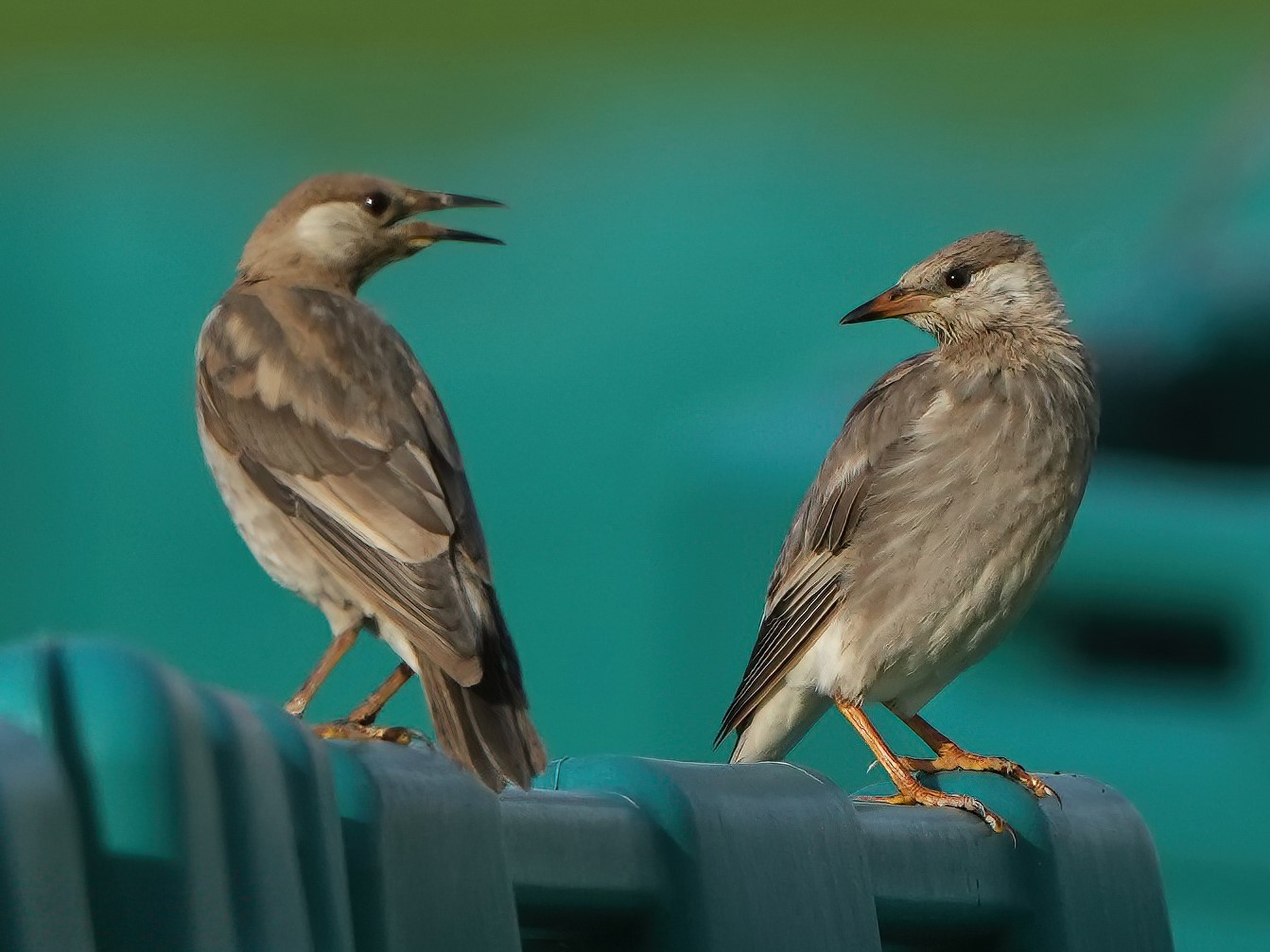
Aug. 2023, Paul Leader. Juveniles.
Juvenile is like female but duller, much paler and has brown streaking on the white cheeks.
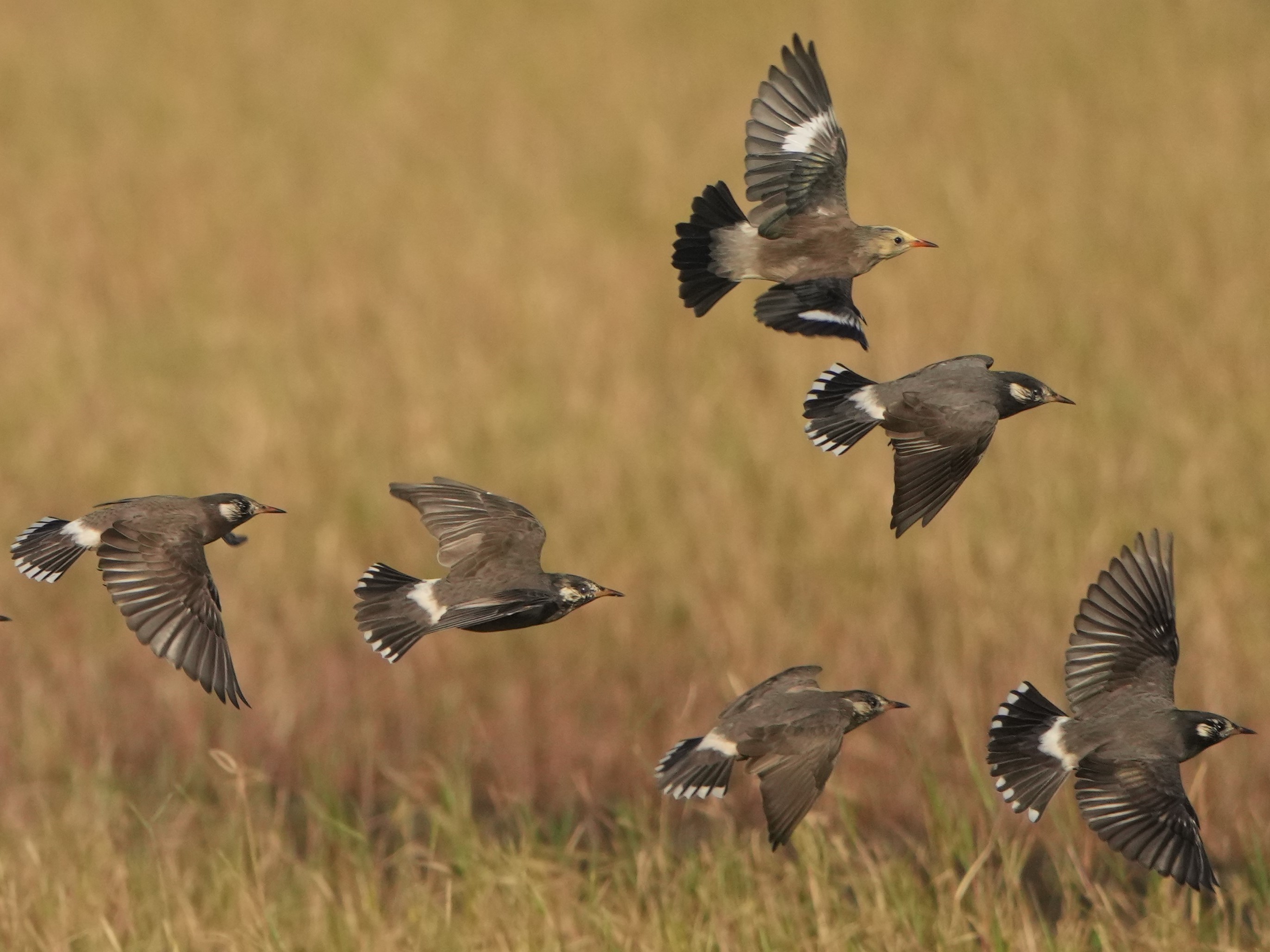
Oct. 2022, Paul Leader. Males and females in flight with female Red-billed Starling.
In flight plain grey-brown apart from broad white tips to all but the central tail feathers, whitish rump band and whitish cheeks. Females and young birds are browner around the head. Lacks the white bases to the primaries and the pale-headed appearance of the Red-billed Starling visible in this photograph.
VOCALISATIONS
Has a distinctive rather nasal and high-pitched ‘tveet’ that is not uttered by Red-billed Starling. Low-intensity song can be heard in early spring. Both can be heard in this recording.
The alarm call is a harsh, drawn out ‘skaaar’, slightly lower-pitched than the equivalent call of Red-billed Starling.
When flushed utters a rolling, grating ‘krrark’.
DISTRIBUTION & HABITAT PREFERENCE
White-cheeked Starling is typically found in lowland open habitats especially in the Deep Bay area. It particularly favours wet agricultural land and fish pond areas and was previously often associated with pig and poultry farms although they have almost disappeared in HK. This may at least partially explain the decrease in the percentage of occupied 1km squares from 2.4% to 1.7% between the Winter Atlas surveys of 2001-05 and 2016-19. The breeding bird surveys of 1993-96 and 2016-19 showed an increase from 0.0% to 0.2%, reflecting the establishment of a small breeding population.
Most records are from Mai Po, Lok Ma Chau, Lut Chau and Tai Sang Wai, Long Valley and San Tin. There were more records in Kam Tin and Nam Sang Wai during the 2000s but the species is now rare there. Conversely, there are more records at Ho Sheung Heung, Fung Lok Wai and Mai Po San Tsuen in 2010s, though at the former of these sites the reason is at least in part due to increased observer coverage.
It is rare away from the New Territories, though low numbers are recorded almost annually on passage on Po Toi. It is very rare on other islands, but has been recorded on Lamma, Lantau and HK Island (in HK Park). It has also been recorded rarely close to the urban area (e.g. Ho Man Tin, Kwai Chung).
OCCURRENCE
Prior to its regular occurrence in summer, the earliest winter birds were recorded in early October. Most birds arrive in early November and numbers remain relatively constant until the third week of February. A further fall in numbers occurs in mid to late March, after when it is rare (Figure 1).
Numbers in summer are low in general as the breeding population is much smaller than the wintering population. However, flock size can occasionally reach over 50 at Mai Po (100 birds on 27 June 2013 and 70 on 19 June 2020). Flocks of both Red-billed and White-cheeked Starling are also present at Fu Tian, Shenzhen in the summer, and there is no doubt overlap with the birds that occur there.
In the 1980s the numbers recorded were very low, after when it became abundant in the 1990s and early 2000s. However, numbers declined again from winter 2012/13, with the aggregated peak weekly count per winter period since then lower than 200 birds (Figure 2).
The highest count is 600 at Mai Po on 20 February 1999. Other high counts are also from Mai Po but generally before 2010 (e.g., 330 on 13 November 2003 and 323 on 10 November 2002).
Swinhoe (1861) observed flocks of White-cheeked Starlings ‘on the mainland opposite Hong Kong’ (which must refer to either the Kowloon peninsula or perhaps the New Territories), and Kershaw (1904) considered it to be an uncommon winter visitor to the Pearl River delta region. However, it was not mentioned at all by Vaughan and Jones (1913), nor was it listed by Hutson (1930) in his review of the Sturnidae of Hong Kong. Herklots (1953) still only listed two records (in 1931 and 1936) which both appear to refer to single birds. Dove and Goodhart (1955) recorded a flock of 60 on the Mong Tseng peninsula on 7 December 1952 but they apparently had no other records. Walker (1958), however, considered it a fairly common winter visitor between 5 October and 2 April.
BREEDING
A small population has over-summered and bred locally since the early 2000s. While birds in the breeding season were very unusual last century, apparent pairs became more commonly recorded from 2004 and birds carrying food into nest were first reported at Kam Tin on 23 May 2005. More breeding records were observed subsequently, with juveniles common from late-May to mid-September. Mixed flocks of adults and juveniles are seen in summer indicating a larger breeding population in the region.
BEHAVIOUR, FORAGING & DIET
Gregarious, often forming flocks of more than 20 birds. Sometimes mixed with other starlings, including Red-billed Starling, Black-collared Starling and Crested Myna. Roosts communally. Although omnivorous, it is probably the most frugivorous of the starlings in HK. In the second half of winter in particular it is attracted to the fruits of the exotic Persian Lilac Melia azederach, which is common in the northwest New Territories. It also feeds on nectar (e.g., Bombax ceiba).
RANGE & SYSTEMATICS
Monotypic. Breeds from Transbaikalia to the Russian Far East, east Mongolia, northern China (Qinghai to Heilongjiang), Korea, south Sakhalin through most of Japan. Winters in Japan (except Hokkaido), South Korea, southeast China (including Hainan and HK), Taiwan and northeast Vietnam (Craig and Feare 2020).
CONSERVATION STATUS
IUCN: Least Concern. Population trend unknown.
Figure 1.
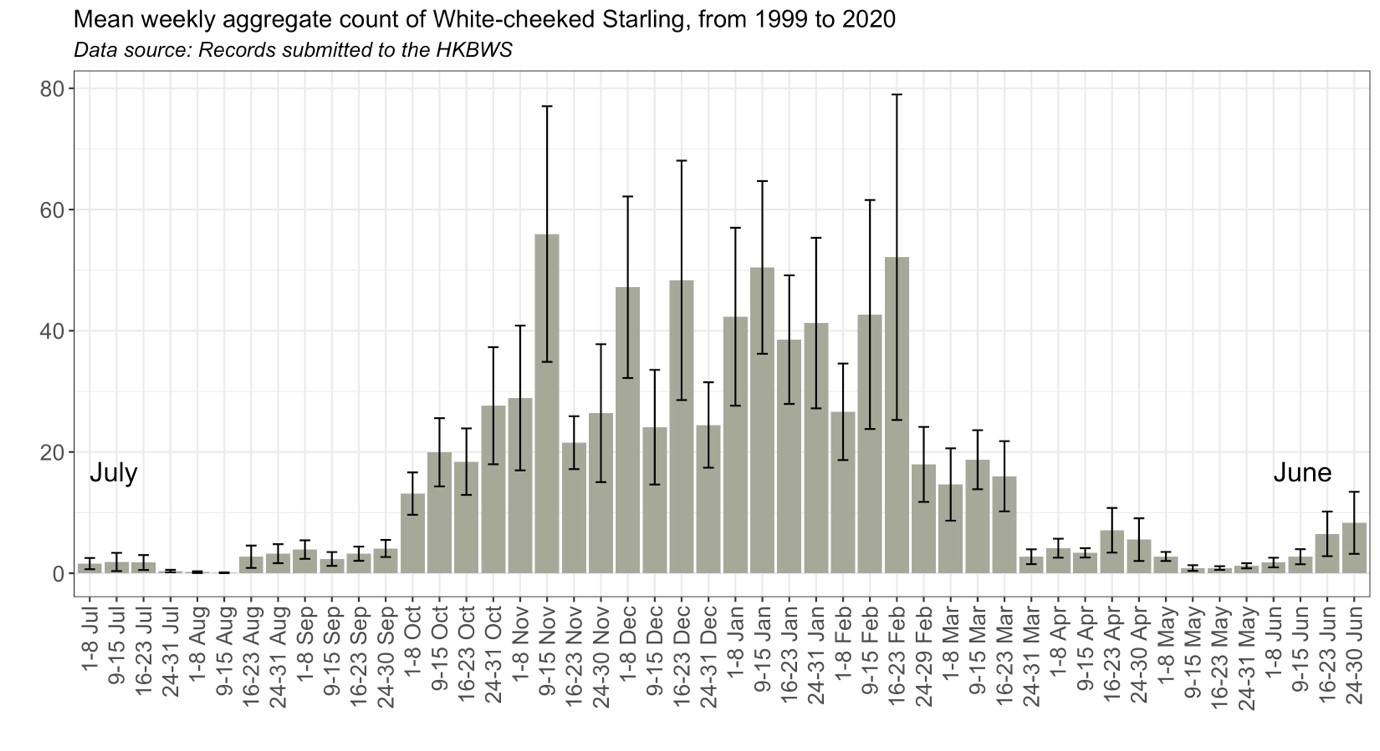
Figure 2.

Craig, A. J. F. and C. J. Feare (2020). White-cheeked Starling (Spodiopsar cineraceus), version 1.0. In Birds of the World (J. del Hoyo, A. Elliott, J. Sargatal, D. A. Christie, and E. de Juana, Editors). Cornell Lab of Ornithology, Ithaca, NY, USA. https://doi.org/10.2173/bow.whcsta1.01
Dove, R. S. and H. J. Goodhart (1955). Field observations from the Colony of Hong Kong. Ibis 97: 311-340.
Herklots, G. A. C. (1953). Hong Kong Birds. South China Morning Post, Hong Kong.
Hutson, H. P. W. (1930). The birds of Hong Kong. Hong Kong Naturalist 1: 2-7.
Kershaw. J. C . (1904). List of birds of the Quangtung Coast, China. Ibis 1904: 235-248.
Swinhoe, R. (1861). Notes on the ornithology of Hong Kong, Macao and Canton, made during the latter end of February, March, April and the beginning of May 1860. Ibis 1861: 23-57.
Vaughan, R. E. and K. H. Jones (1913). The birds of Hong Kong, Macao and the West River or Si Kiang in South-East China, with special reference to their nidification and seasonal movements. Ibis 1913: 17-76, 163-201, 351-384.
Walker, F. J. (1958). Field observations on birds in the Colony of Hong Kong. Hong Kong Bird Watching Society, Hong Kong (duplicated).

